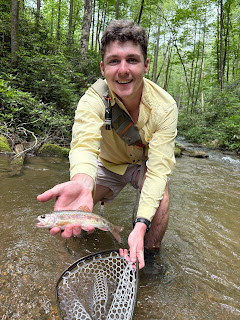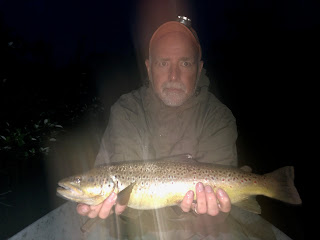The heat continues and it’s driven a lot of folks indoors. Brave anglers can still find some nice opportunities early, late, and in the shade along mountain streams. Headwaters are low, clear, and warm. Blueline trout are a best bet for early risers here in GA and in the higher mountains just north of our border. Stockers are still going strong; just check water temps and hit those streams before the midday sun cooks them. Less rainfall means that bass rivers are finally falling into shape for float fishers. Ponds are still good early and late, when the shadows are on them. Reservoirs are challenging with summer boat traffic, but the shallow spotted bass bite is good when the wind puts a chop on the water.
Check out all of our detailed intel at our blog. It’s new every Friday and will help you boost your own catch rates.
http://blog.angler.management/
(Link in bio)
Stop in either one of our two UO shops for some flies, supplies, and advice. Have fun this summer!
Helen: 706-878-3083. Open 8-5 daily.
Clarkesville: 706-754-0203. Open 8-5 from Monday thru Saturday.
Unicoi Outfitters: Friendly. Local. Experts.
www.unicoioutfitters.com
Wes’ Hot Fly List:
Dries: purple haze, tan elk hair caddis, parachute and hard body ants, micro chubby Chernobyl, yellow humpy.
Nymphs & Wets:
Stockers: red squirmy worm, peach egg, micro girdle bug, black woolly bugger, tan and olive mops, pink tag jig.
Mountain streams: hares ear, drowned ant, pheasant tail nymph and soft hackle, green weenie, prince nymph.
Streamers:
Sparkle minnows, small black and olive buggers, bank robber sculpin, micro dungeon.
(Bass & stripers) stealth bomber, polar changer, yard sale, clawdad, thrasher.
(Panfish) mini stealth bomber, Boogle popper #8, Amnesia bug, brim reaper, girdle bug.
(Carp) squirmy hybrid, carp bitters, Detroit city mop.
Headwaters:
They’re low and clear and warming. Hit them before lunch, unless you find colder water on north slope streams.
Yesterday’s stream recons at 11AM provided this intel: Spoilcane ran 68F,
the Hooch at the lower WMA boundary was 68F,
and a high Hooch trib was already 65F.
Toss small dries on light line (5 or 6X) into the drought refuges where wild fish are retreating to. It’s hard to beat an ant, Adams, or tan caddis on top. For deeper pools, drop an ant or green weenie behind that dry. Stealth and a good drift will be more important than fly pattern. Quit your trip when the water rises above 66F to protect those finned critters.
https://www.instagram.com/reel/DLXe4hXsbfl/?igsh=NXl1ZzZsdmFtYmVz
UO buddy Cooper: “Went blue lining last weekend and found some beautiful wild rainbows. Stained water allowed us to get a little closer to pools, and was especially helpful when my friend showed up in a yellow shirt. They were eating royal wulffs. Love that water is much higher than last summer.”
Stockers:
Stocker fishing is still good in the mornings, before water temps hit about 68 or 70F. Beyond that the bite slows, so get up early or aim for a shady stream higher up the mountain. Stockers are intended for harvest, so don’t feel bad about fishing for them at higher temps if you intend to take them home. Squirmies, eggs, fluffy chubbies, and small buggers will put your new fly fisher on some stockers. For younger kids, 4 or 6 pound test line, size 10 or 12 hooks, and smaller baits like a single salmon egg or 1/3 of a nightcrawler will appeal best to stockers with smaller appetites in warming waters.
Today’s weekly stocking list should be posted here around 3 or 4PM:
https://georgiawildlife.com/Fishing/Trout
I expect a decent list today, but a very long list next week to serve the July 4th holiday crowds. Take advantage of the heavy stockings now before they subside for the second half of the summer. See the “2025 Frequencies” list on that WRD trout page to see the summer stocking plan.
Private Waters:
We’re now done with our spring trout trips because of hot water. Feel free to call our shop now to reserve some prime fall weekend dates after October 15, a rough estimate for our reopening of private trout water opportunities.
Reminder:
We are still offering flyfishing-only striper trips at Nacoochee Bend. Call the Helen shop at 706-878-3083 for details and to make your reservation.
Florida fishing guide Ralph and his son, Matthew, had a big time on their midweek trip to The Bend. Their hot fly that evening was, of all things, a small shrimp pattern that the duo uses on the salty excursions. I guess it resembled a crayfish. Either way, it worked, even in clear water.
Tailwaters:
The Hooch, Toccoa, and rivers north of GA remain a best bet during the summer as they release cold winter waters. Watch the generation schedules and get out there early, while the sun is still below the tree line. While the fish are cold all day, you’ll be a lot more comfortable in the lower light.
UO buddy Ryan: “We've hit the Hooch tailwater several times lately to prepare for a fly fishing competition this weekend. It's taking 6.5x-7x tippet to fool them in this section of super-clear river. Fish have been seen rising to dries, and our friend did well with a dry/dropper rig. For the stress of the finesse, we've been rewarded with some beautiful, wild Hooch browns!”
Warm Rivers:
Aren’t we glad that the federal government has restored funding for the Hooch river gauges?
Region rivers are dropping and clearing, with just the occasional muddy flows from a sudden storm. The Hooch at Highway 115 was looking mighty fine for shoal bassin’ when I crossed it last night and again this morning on my way to our Clarkesville store.
Grab your crawdad flies and your stealth bombers and start your summer bass floats on the region’s rivers. We have a nice selection of bugs to choose from.
https://www.instagram.com/p/DLFb9opsiFi/?igsh=d2c1dDg4cDhwY2Jp
Ponds & Lakes:
Hank the Yank said Lanier’s topwater bite for spotted bass on the fly has been good IF the surface is choppy. His flyrodders have needed some clouds and wind to be successful when tossing feathers. Henry advises to watch the forecast and aim for any day that won’t be flat calm, with a glassy surface on Lanier. More on Henry here:
https://www.henrycowenflyfishing.com/welcome.html
UO buddy AJ: “I've had a few Lanier spotted bass trips over the past couple of weeks. We've been seeing quite a few small groups busting on top, but they have not been easy to get on with fly tackle. Long, quick casts with spinning tackle gives you a much better chance to get a lure in while they're splashing. A hard or soft swim bait will usually get a strike in you cast in quickly enough. Topwater lures and shallow fluke-style plastics will also draw up some fish from brush piles in the 20-30ft depths on long points and humps. I like to fish chrome on sunny days and bone or white on cloudier days. A little wind definitely helps with the topwater bite. If it's flat out, try a more subtle lure. This bite should continue for the next couple of weeks. Reach out if you're interested in getting out there! My website is: www.lanieronthefly.com.”
Afar:
The high elevation streams in NC are still a real good bet. Toss sone yellow sallies, wet and dry ants, and green weenies. Catch some daily park stream conditions and angling tips here, thanks to our friends at LRO:
https://littleriveroutfitters.com/
Unicoi co-owner David recently fished the Hex hatch at night in Wisconsin. Enjoy the pic of his hefty brown trout on a big ole mayfly dry.
News:
We had a big win for public lands at midweek, BUT…
The US Senate is still proposing the YOUR federal lands in the budget reconciliation process. Stay engaged!
If you share our view that this should NOT happen, then contact your US senators NOW and voice your opposition.
From TU-National:
https://www.facebook.com/share/16fjt3P2Ku/?mibextid=wwXIfr
“You can’t make this stuff up. After the initial proposal was struck down by the Senate Parliamentarian, there’s a new proposal to sell your public lands... and it still stinks.
“Hunters, anglers and outdoor enthusiasts of every political stripe have made clear that mandatory public land sales are a boneheaded idea,” said TU’s President and CEO Chris Wood. “Hunters and anglers are heartened by the growing, bipartisan coalition in Congress who oppose the sale of the places we hunt and fish. House and Senate leadership needs to do the right thing and keep all public land sales out of reconciliation.”
“To be certain, opportunities exist to identify limited and targeted public lands that can or even should be sold or traded to support community expansion; that process should play out in the bright light of day with public involvement. The ham-handed approach of the Senate language would result in a dark of night fire sale of public lands to people who would quickly erect fences and post no trespassing signs.”
Tell your senators NO to selling public lands via the Capitol Switchboard at (202) 224-3121 or send them a message here: https://bit.ly/43xr4hg
That’s the latest, rather thin intel after our hot week of fewer trips abroad. Make some plans now for your holiday time on the horizon. Stop in either UO shop and we’ll help you find some good options for your summer angling exploits. Good luck!
Unicoi Outfitters: Friendly. Local. Experts.
www.unicoioutfitters.com



























